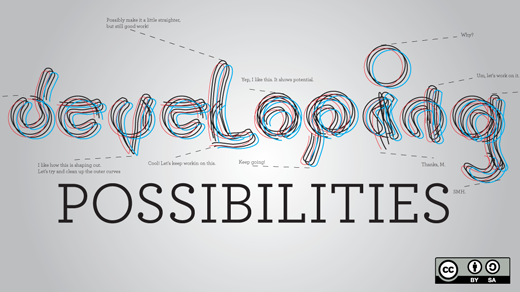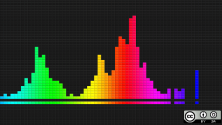Many people say that looks don’t matter. But for many technology projects, looks can be a selling point. An attractive user interface, a well-designed website, and marketing material—even nice-looking swag goes a long way with users.
Sean Martell understands this. As Art Director for Mozilla, he’s one part of a team behind Mozilla’s visual design. Lately, he’s been involved in redesigning Mozilla’s iconic logos. Instead of working behind closed doors, Martell and his colleagues have opened up the design process to get the help of the wider Mozilla community.
Martell spoke with Opensource.com ahead of his talk, Open Design and the Firefox Logo, at the upcoming All Things Open conference. In this interview, Martell discusses why Mozilla went open with the design process and shares the surprising results.

Why did Mozilla decide to change the design of the Firefox logo?
The redesign of the Firefox logo was actually considered for a few reasons. One major push was the run towards releasing our mobile platform: Firefox OS. We wanted to clean up the logo and balance the level of detail with small screen readability. On top of that, the previous version of the logo had been produced using many Adobe Illustrator-only filters and techniques.
A goal of the rebuild was to strip it back and use solid gradients so it could be easily saved as a SVG file so that our greater community could use the files without being tied to a particular design package while also having it as a web-friendly format.
Who at Mozilla was involved in the redesign?
For the Firefox logo, the majority of the process wasn't as open as we would have liked, in hindsight. We were actually called out by some of our community as a result. Those involved were mainly people within the Engagement (Marketing) team at Mozilla. We're working to nail down open channels that we can continue to use going forward to avoid any radio silence on future works.
The concept of open design is often associated with physical items. How did you adapt the concept to something digital?
Being open at Mozilla is part of our core value set and helps us further our mission of promoting openness, innovation, and opportunity on the Web.
Learning from the Firefox redesign, we saw how our energy was targeted at opening up opportunity for others by altering how we built and saved the Firefox assets, but sharing the process in which we achieved that was where our community wanted to be more involved.
Now that we're in the middle of evolving the Mozilla brand itself, we're blowing the doors wide open on the step-by-step process of designing a logo and greater brand system. We're using this project to fine tune what open design means for our team and how it can impact our community.
Why open design?
What open design is for us as a team is now evolving and helping define how far we can push being transparent in our work—from complete design process to end product assets. We share our creative files on our asset repository and we also share our techniques and styles, sometimes live.
The ability to share our work in such a way is an excellent tool to teach basic day-to-day design techniques and also mentor any designers who would perhaps want to contribute to design at Mozilla. We're still learning when it comes to this, but we're trying to implement a plan now to make it easier for designers to contribute to design projects within Mozilla.
How did you engage the Mozilla community (and the wider web) in the design process?
We've set up an excellent set of engagement routes within this latest branding project. Live streaming my desktop, IRC channel interaction for feedback and suggestions, community mailing list updates and surveys, brown bag seminars (lunchtime information sessions), and regular blog posts—we're ensuring that the journey to a final evolved brand is just as important as the brand mark itself.
What kind of feedback did you get from the community? Was the feedback useful?
Most of the feedback has been very positive with very little criticism, which is a fantastic boost while working. What was very welcome were ideas on how we could extend the idea of a living brand and having that feedback push us to see how we could expand the brand system further. We’re now building the results of those suggestions into the project.
Did using the open design approach help make coming up with a new logo faster, or did it slow you down?
Looking at the open design approach as something that slows down the work shouldn’t come into play if you make it a mandatory part of the overall design process. There is a small amount of time involved to set up sharing things live and pausing for feedback responses, but it’s all part of the process and once in place feels very natural within the flow of work.
Do you think that the Mozilla community gained a new appreciation for Mozilla's design process?
I would hope that the community gets more than a general appreciation of the process from this and more of an overall understanding of how we work so that it can not only help shape the feedback they give, but also encourage some to dive in and take up designing themselves.
The ideal end product of an open design process for me is having other designers take our techniques/methods/solutions and expand their own skill sets with any knowledge gained. Helping build talent within the community helps build the greater organization. It’s what we call One Mozilla.
What were the biggest lessons that you learned from doing this?
Our community is a vital asset to our success and we need to keep pushing ourselves to be as open as we can in our day-to-day to ensure that they have an opportunity to share their ideas with us and help shape our work. Mozilla is built on community and we want our work to represent their passion and drive as closely as possible.
In the future, will you be following an open design approach when refreshing Mozilla's graphics, logos, and overall design?
Of course! Being open is part of who we are. Our goal going forward is to see where and how we can continue to bake openness into our work—see what works and what doesn’t and constantly evolve the process to make it easier for others to take part and help us tell the Mozilla story.
See the full series of All Things Open 2014 speaker interviews.








Comments are closed.